Dumpster Diving in Google Photos Android App: "local_trash.db"

This article will explore the Trash within the Google Photos Android App. If you delete any media file from Google Photos on your mobile device, the deleted media file would then be relocated to the Trash within Google Photos. All items inside Trash will be permanently deleted after 60 days in Trash. In fact, the information of the Google Photos Trash items will be stored inside the " local_trash.db " under " /data/com.google.android.apps.photos/databases/ ": The " local " table of " local_trash.db " contains most of the useful information, including " local_path " ( the original path of the deleted media file ), " trash_file_name " ( a UUID value that becomes the new name of the deleted media file ), " deleted_time " ( a Unix timestamp in milliseconds that recorded the delete time ), " is_video " ( where "0" = "no", "1" = "yes" ), etc. As soon as a media file was